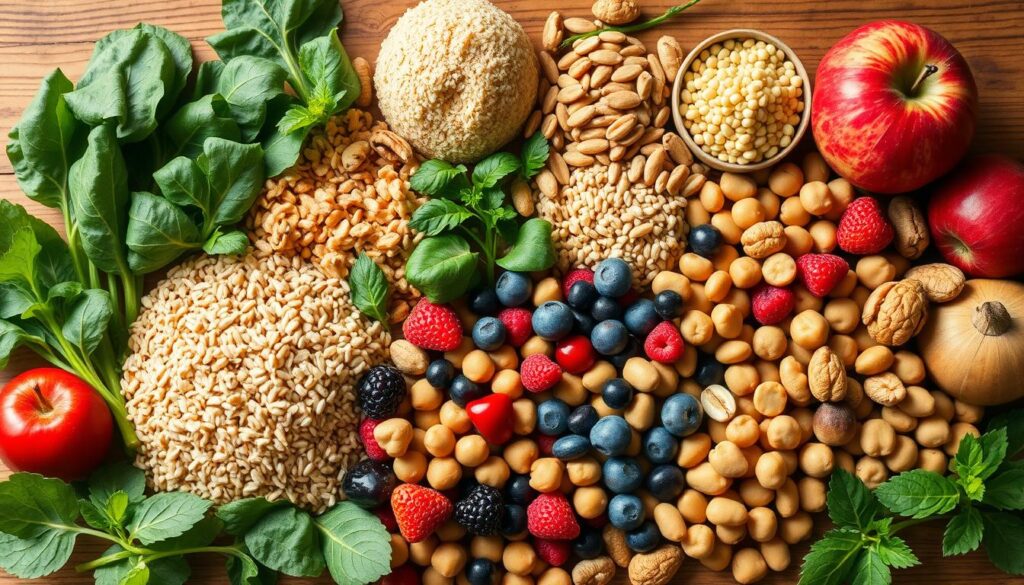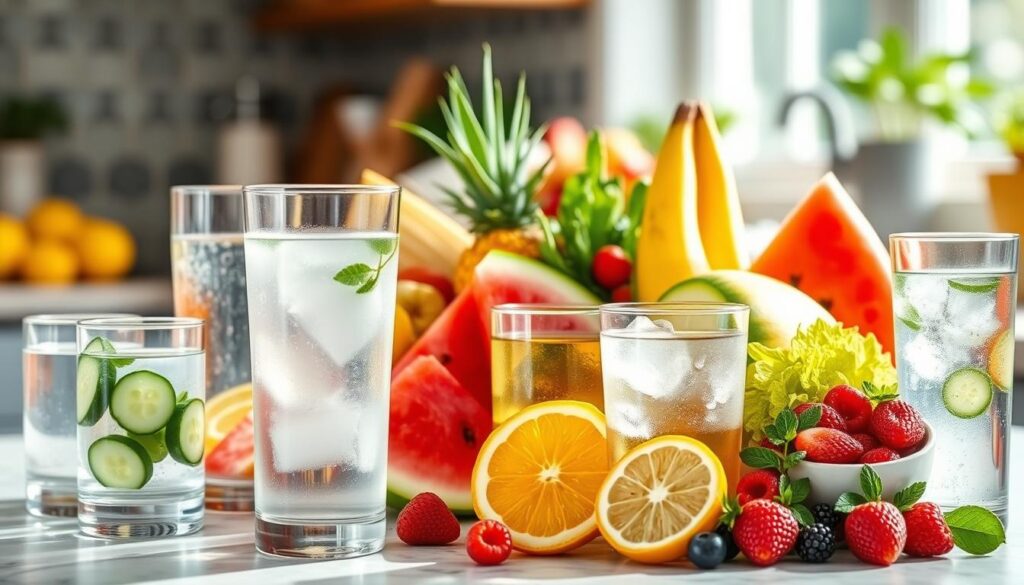Living with diabetes means we must focus on a balanced diet to control our blood sugar. Finding the right foods can be tough, but it’s doable. This guide will share 10 essential diet tips for diabetics to manage blood sugar.

Key Takeaways
– Understand the different types of carbohydrates and their impact on blood sugar levels
– Practice portion control and create balanced meals to maintain a healthy weight
– Incorporate fiber-rich foods to slow the absorption of carbs and regulate blood sugar
– Stay hydrated by limiting sugary beverages and opting for water or low-calorie alternatives
– Monitor blood sugar levels regularly to adapt your diet and lifestyle accordingly
Understand Carbohydrates and their Impact
As diabetics, knowing how carbs affect your blood sugar is key. Carbs, or “carbs,” are a main part of our diet and impact blood sugar. By understanding carb types and their glycemic properties, you can manage your blood sugar and weight better. This can be done through a calorie deficit or using weight loss supplements.
Different Types of Carbs
Carbs fall into two main groups: simple and complex. Simple carbs, or “refined” carbs, are quickly absorbed and raise blood sugar fast. Examples include table sugar and white bread. Complex carbs, or “whole” carbs, are digested slower and release energy more steadily. These include whole grains and vegetables.
Glycemic Index and Load
The glycemic index (GI) and glycemic load (GL) are crucial for diabetics. The GI shows how quickly a food raises blood sugar. High-GI foods cause a quick spike, while low-GI foods have a gentler effect. The GL considers both GI and carb amount, giving a fuller picture of a food’s impact on blood sugar. Choosing low-GI and low-GL foods helps diabetics manage blood sugar and weight, whether through diet or supplements.
Portion Control and Balanced Meals
For diabetics, controlling portions and eating balanced meals is key. It helps manage blood sugar and keeps us healthy. Eating the right amounts of nutrient-rich foods helps regulate blood sugar and supports a healthy weight.
Let’s look at some important tips for portion control and balanced meals:
- – Lean Proteins: Add lean proteins like grilled chicken, fish, tofu, or beans to your meals. They keep you full and support muscle health.
– Whole Grains: Choose whole grains like brown rice, quinoa, or whole wheat bread. They’re full of fiber, which helps with blood sugar and digestion.
– Fruits and Vegetables: Make half your plate colorful fruits and veggies. They’re fat burning foods and packed with vitamins and antioxidants.
– Healthy Fats: Add small amounts of healthy fats like olive oil, avocado, or nuts to your meals. They help you feel full and are good for your heart.
– Portion Sizes: Watch your portion sizes to avoid blood sugar spikes and weight gain. Use your hand or a standard plate to gauge portions. - By following these tips and making a balanced meal plan for weight loss, you’re on the path to losing weight fast and managing your diabetes well.
Incorporate Fiber-Rich Foods
For people with diabetes, eating a balanced diet is key. Fiber-rich foods are a big part of this. They help control blood sugar by slowing down carb absorption.
Focus on adding veggies, whole grains, legumes, and fruits to your meals. These foods are full of fiber. They help keep blood sugar stable.
Vegetables like broccoli, spinach, and Brussels sprouts are great for fiber. Whole grains, like oats and quinoa, also offer fiber. Legumes, such as lentils and chickpeas, are high in fiber and protein.
Adding fiber-rich foods to a 7 day diet plan for weight loss or a ways to lose stomach fat fast plan can help diabetics. Fiber makes you feel full, aiding in tips for losing weight. It also helps manage blood sugar and overall health.

Start slow with fiber-rich foods to ease digestion. Begin with small amounts and increase gradually. With some planning, you can make fiber-rich foods a part of your diet. This supports your health and diabetes management.
Stay Hydrated and Limit Sugary Beverages
As diabetics, it’s crucial to stay hydrated and cut down on sugary drinks. Water and unsweetened beverages are best for keeping our bodies hydrated and blood sugar levels stable.
Sugary drinks like soda, fruit juices, and sweetened coffee or tea can raise our blood sugar. These drinks have added sugars that quickly increase our glucose levels. This makes it hard to keep our diet healthy. We should drink water, unsweetened herbal teas, or sugar-free drinks instead.
Drinking enough water is key for our health. It helps with body temperature regulation, digestion, and kidney function. Drinking water helps keep our bodies hydrated, reducing dehydration risks and complications.
- – Aim for at least 8 cups (64 ounces) of water per day, or more if you are physically active or in a hot environment.
– Choose unsweetened, non-carbonated beverages, such as herbal teas or infused water, to add variety to your hydration routine.
– Limit or avoid sugary drinks, including soda, fruit juices, and sweetened coffee or tea, as they can disrupt blood sugar control. - By staying hydrated and avoiding sugary drinks, we make a big step in managing our diet. Remember, even small changes can greatly improve our health.

Monitor Blood Sugar Levels Regularly
As diabetics, we know how key it is to watch our blood sugar closely. Tracking our glucose helps us see how our bodies react to food, exercise, and meds. This is vital for staying healthy and avoiding big problems.
Our daily checks help us make smart choices about what we eat and do. Knowing our blood sugar in real-time lets us pick the best options for us. This constant checking is a big part of managing our diabetes.
By keeping an eye on our blood sugar, we spot patterns and trends. This lets us work with our doctors to adjust our treatment. Regular checks are a key part of living well with diabetes
